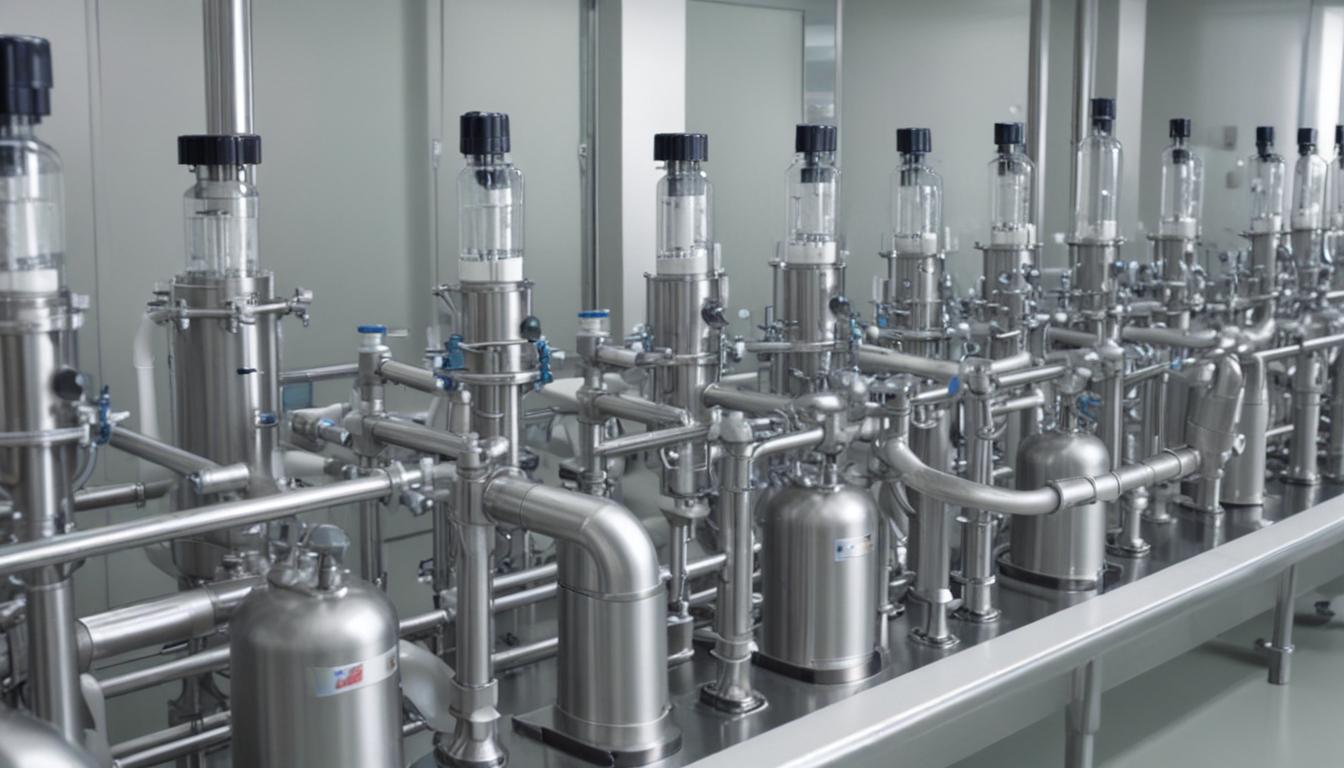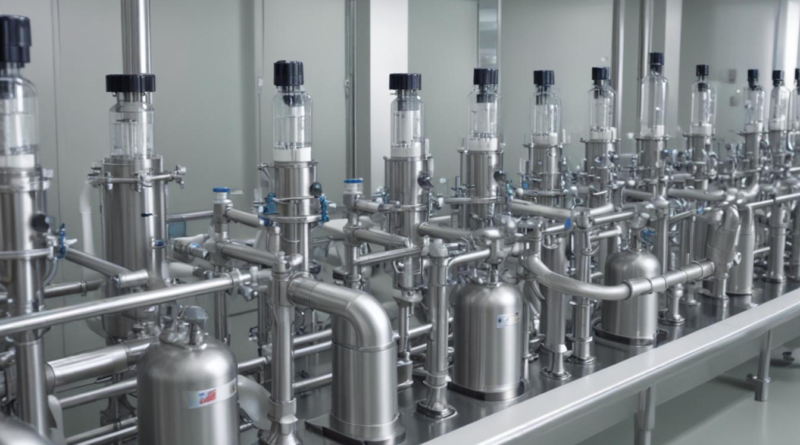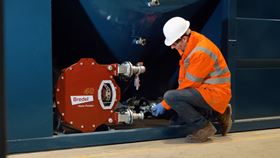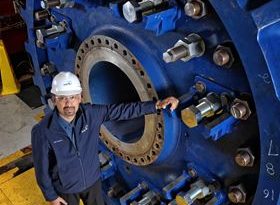pumps used in the pharmaceutical formulation
In pharmaceutical formulation processes, selecting the appropriate pump type is crucial for ensuring precision, efficiency, and compliance with regulatory standards. Various pharma formulation pumps are employed, each offering unique advantages tailored to specific applications.
Peristaltic Pumps are widely used due to their ability to handle sterile and corrosive fluids. They operate by compressing a flexible tube, creating a pulsing flow that minimizes contact between the pump mechanism and the fluid, thereby reducing contamination risks. These pumps are ideal for applications requiring easy maintenance and sterilization.
Gear Pumps utilize interlocking gears to move fluids, providing a consistent and controlled flow rate. Their robust design makes them suitable for handling viscous liquids and ensuring precise metering, which is essential in formulations requiring exact ingredient proportions.
Diaphragm Pumps function by flexing a diaphragm to generate flow, allowing for excellent control over flow rates and pressure. They are particularly advantageous for handling abrasive or particulate-laden liquids, as their design prevents wear and tear on critical components.
Piston Pumps offer high-pressure capabilities and are used in applications where volumetric precision is paramount. By moving pistons within cylinders, these pumps deliver accurate dosing, making them suitable for formulations that demand meticulous ingredient integration.
Syringe Pumps provide exceptional accuracy and are typically employed in laboratory settings or for small-scale production. They deliver fluids in precise, incremental amounts, ensuring consistency in formulations that require exact dosing.
To further illustrate the characteristics and suitability of each pump type, the following table summarizes key attributes:
| Pump Type | Key Features | Typical Applications |
|---|---|---|
| Peristaltic | Minimal contamination, easy maintenance | Sterile fluid transfer, corrosive liquids |
| Gear | Consistent flow, handles high viscosity | Exact metering, viscous formulations |
| Diaphragm | Handles abrasive fluids, precise control | Abrasive liquids, particulate-laden solutions |
| Piston | High pressure, volumetric precision | Accurate dosing, high-pressure applications |
| Syringe | Exceptional accuracy, small-scale | Laboratory use, precise dosing needs |
Additionally, understanding the specific applications within pharmaceutical formulation helps in selecting the most suitable pump type. Factors such as fluid viscosity, required flow rate, sterility needs, and the presence of particulates play a significant role in determining the optimal pump selection.
- Viscosity Management: For highly viscous formulations, gear or piston pumps are preferable due to their ability to maintain consistent flow rates.
- Sterility Requirements: Peristaltic pumps are ideal for maintaining sterile conditions as they limit direct contact between the pump mechanism and the fluid.
- Precision Dosing: Syringe and piston pumps offer the high precision necessary for formulations demanding exact ingredient measurements.
By comprehensively understanding the various types of pumps and their respective strengths, pharmaceutical manufacturers can optimize their formulation processes, ensuring both quality and efficiency in drug production.
applications of pumps in drug formulation processes
Pumps play a vital role in various stages of drug formulation processes, ensuring precise handling and transfer of ingredients, maintaining product integrity, and optimizing manufacturing efficiency. Their applications span across multiple facets of pharmaceutical production, each requiring specific pump characteristics to meet stringent quality and regulatory standards.
Ingredient Transfer and Metering: Accurate transfer and metering of active pharmaceutical ingredients (APIs) and excipients are fundamental to drug formulation. Pumps such as piston and syringe types are employed to achieve precise dosing, ensuring that each batch meets the exact specifications required for efficacy and safety.
Mixing and Homogenization: Uniform mixing of components is critical to achieve consistent product quality. Diaphragm and peristaltic pumps facilitate thorough mixing by providing consistent flow rates and minimizing shear stress, which is essential for maintaining the stability of sensitive formulations.
Sterile Processing: In the production of sterile pharmaceuticals, maintaining aseptic conditions is paramount. Peristaltic pumps are preferred in these applications as they limit direct contact between the pump mechanism and the sterile fluid, reducing contamination risks. This makes them ideal for sterile fluid transfer and filling processes.
Viscous Liquid Handling: Formulations with high viscosity require robust pump solutions to ensure smooth handling and transfer. Gear and piston pumps are well-suited for these applications due to their ability to maintain consistent flow rates despite the increased resistance posed by viscous liquids.
High-Pressure Applications: Certain formulation processes, such as high-pressure homogenization, necessitate pumps capable of operating under elevated pressures. Piston pumps, with their high-pressure capabilities, are utilized to achieve the necessary force for breaking down particles and ensuring uniform dispersion.
Lyophilization and Freeze-Drying: Pumps are integral to the freeze-drying process, where precise control over the transfer of solvents and other volatile components is required. Diaphragm pumps are commonly used in these applications due to their ability to handle low-flow rates and maintain vacuum conditions essential for lyophilization.
Filling and Packaging: Accurate and efficient filling of containers is critical to pharmaceutical packaging. Syringe and peristaltic pumps are often employed in the filling lines to ensure precise volume delivery, minimizing waste and ensuring each container meets dosage requirements.
Cleaning and Sanitization: Effective cleaning and sanitization of equipment are essential to prevent cross-contamination. Peristaltic pumps are frequently used in cleaning-in-place (CIP) systems as they can efficiently circulate cleaning agents without exposing the fluid to pump components, ensuring thorough and hygienic cleaning processes.
The following table highlights specific applications of various pump types within the drug formulation process:
| Application | Preferred Pump Type | Reason for Selection |
|---|---|---|
| Precise Dosing of APIs | Piston, Syringe | High accuracy and volumetric precision |
| Sterile Fluid Transfer | Peristaltic | Minimizes contamination risks |
| Handling Viscous Excipients | Gear, Piston | Maintains consistent flow rates |
| Mixing and Homogenization | Diaphragm, Peristaltic | Provides consistent flow and minimizes shear stress |
| High-Pressure Homogenization | Piston | Operates under elevated pressures |
| Lyophilization Processes | Diaphragm | Handles low-flow rates and maintains vacuum conditions |
| Filling and Packaging | Syringe, Peristaltic | Ensures precise volume delivery |
| Cleaning-In-Place (CIP) | Peristaltic | Efficiently circulates cleaning agents without contamination |
Understanding the diverse applications of pharma formulation pumps enables manufacturers to select the appropriate pump types that align with their specific process requirements. This ensures not only the quality and consistency of the pharmaceutical products but also enhances overall operational efficiency and compliance with regulatory standards.
- Scalability: Pumps must accommodate varying production scales, from small-scale laboratory settings to large-scale manufacturing facilities.
- Compatibility: The selected pump must be compatible with the chemical and physical properties of the fluids being handled, including pH levels, temperature, and viscosity.
- Regulatory Compliance: Pumps used in pharmaceutical applications must adhere to strict regulatory standards, such as those set by the FDA and EMA, ensuring they meet hygiene and quality requirements.
By meticulously aligning pump selection with specific formulation applications, pharmaceutical manufacturers can achieve optimal performance, minimize risks, and maintain the high standards required in drug production.
factors influencing pump selection
When selecting the appropriate pharma formulation pumps, several critical factors must be considered to ensure optimal performance and compliance with industry standards. These factors encompass both the technical specifications of the pump and the specific requirements of the pharmaceutical formulation process.
1. Fluid Properties:
The physical and chemical characteristics of the fluids being handled play a pivotal role in pump selection.
- Viscosity: Highly viscous fluids require pumps with robust mechanisms, such as gear or piston pumps, to maintain consistent flow rates.
- Corrosiveness: For corrosive liquids, materials resistant to chemical degradation, like stainless steel or specialized polymers, are essential to ensure longevity and prevent contamination.
- Particulate Content: Fluids containing solids or particulates necessitate pumps with designs that minimize clogging and wear, such as diaphragm pumps.
- Temperature: Pumps must withstand the operating temperatures of the formulation process, whether it involves heating or cooling stages.
2. Process Requirements:
Understanding the specific demands of the formulation process is crucial for selecting a compatible pump.
- Flow Rate: The required volume of fluid to be pumped per unit time dictates the pump’s capacity. Accurate dosing applications may favor syringe or piston pumps for their precision.
- Pressure: Processes that operate under high pressure, such as homogenization, require pumps capable of maintaining elevated pressures without compromising integrity.
- Flow Type: Whether the process demands continuous or intermittent flow influences the choice of pump type.
3. Sterility and Contamination Prevention:
Maintaining sterile conditions is paramount in pharmaceutical manufacturing.
- Material Compatibility: Pumps must be constructed from materials that do not react with the pharmaceutical agents and can be easily sterilized.
- Design Features: Minimizing dead volumes and ensuring easy disassembly for cleaning are critical to preventing contamination.
4. Accuracy and Precision:
The level of precision required in dosing and mixing directly impacts pump selection.
- Measurement Accuracy: High-precision pumps, such as syringe and piston types, are necessary for formulations that require exact ingredient proportions.
- Reproducibility: Consistent performance across multiple batches ensures product uniformity and reliability.
5. Scalability and Flexibility:
Pumps should be adaptable to varying production scales and adaptable to different formulation needs.
- Modular Design: Pumps that can be easily scaled or adjusted to accommodate changes in production volume provide operational flexibility.
- Multi-functional Capabilities: Pumps capable of handling various fluid types and process conditions reduce the need for multiple pump systems.
6. Compatibility with Existing Systems:
Integration with current manufacturing infrastructure is essential for seamless operations.
- Interface Standards: Pumps should conform to industry-standard interfaces for easy integration with existing machinery and control systems.
- Automation and Control: Advanced pumps with programmable controls and compatibility with automation systems enhance operational efficiency.
7. Cost Considerations:
Both initial investment and long-term operational costs must be evaluated.
- Capital Expenditure: The upfront cost of the pump must align with the budget constraints while meeting performance requirements.
- Operational Costs: Energy consumption, maintenance requirements, and the availability of spare parts influence the overall cost-effectiveness.
8. Maintenance and Reliability:
Ensuring minimal downtime and ease of maintenance contributes to uninterrupted production.
- Serviceability: Pumps designed for easy access to components facilitate quicker maintenance and repairs.
- Durability: High-quality materials and robust construction enhance the pump’s lifespan and reliability.
9. Regulatory Compliance:
Adhering to regulatory standards is non-negotiable in pharmaceutical manufacturing.
- Certification: Pumps must comply with relevant guidelines and certifications from bodies such as the FDA and EMA.
- Documentation: Comprehensive documentation and traceability support regulatory audits and quality assurance processes.
To summarize, the selection of pharma formulation pumps involves a comprehensive evaluation of multiple factors to ensure they meet the specific demands of the pharmaceutical production process. The following table encapsulates these factors for easy reference:
| Factor | Considerations | Implications for Pump Selection |
|---|---|---|
| Fluid Properties | Viscosity, Corrosiveness, Particulate Content, Temperature | Material selection, pump type suitability (e.g., gear, diaphragm) |
| Process Requirements | Flow Rate, Pressure, Flow Type | Capacity and performance specifications (e.g., syringe, piston pumps) |
| Sterility | Material Compatibility, Design Features | Ease of sterilization, contamination prevention features (e.g., peristaltic pumps) |
| Accuracy and Precision | Measurement Accuracy, Reproducibility | High-precision pump types (e.g., syringe, piston) |
| Scalability and Flexibility | Modular Design, Multi-functional Capabilities | Adaptable pump systems for varying production scales |
| Compatibility with Existing Systems | Interface Standards, Automation and Control | Integration-friendly designs with programmable controls |
| Cost Considerations | Initial Investment, Operational Costs | Balance between performance and cost-effectiveness |
| Maintenance and Reliability | Serviceability, Durability | Ease of maintenance and long-term reliability |
| Regulatory Compliance | Certifications, Documentation | Compliance with FDA, EMA, and other regulatory bodies |
By meticulously evaluating these factors, pharmaceutical manufacturers can make informed decisions regarding pump selection, ensuring that the chosen equipment not only meets the immediate formulation needs but also aligns with long-term operational goals and regulatory obligations.
maintenance and troubleshooting of pharmaceutical pumps
 Regular maintenance is essential to ensure the optimal performance and longevity of pharmaceutical pumps. By adhering to a structured maintenance schedule, manufacturers can minimize downtime, prevent costly repairs, and maintain the integrity of their formulation processes. Effective maintenance encompasses routine inspections, timely replacement of worn components, and adherence to manufacturer guidelines.
Regular maintenance is essential to ensure the optimal performance and longevity of pharmaceutical pumps. By adhering to a structured maintenance schedule, manufacturers can minimize downtime, prevent costly repairs, and maintain the integrity of their formulation processes. Effective maintenance encompasses routine inspections, timely replacement of worn components, and adherence to manufacturer guidelines.
Preventive Maintenance involves scheduled activities designed to prevent unexpected pump failures. These activities include:
- Routine Inspections: Regularly checking for signs of wear, leakage, or unusual noise can help identify potential issues before they escalate.
- Lubrication: Ensuring that moving parts are adequately lubricated reduces friction and prevents premature wear. It’s crucial to use lubricants compatible with the specific pump type and the fluids being handled.
- Calibration: Periodic calibration of pumps ensures that flow rates and pressures remain within specified parameters, maintaining dosing accuracy.
- Component Replacement: Timely replacement of consumable parts such as seals, gaskets, and tubing in peristaltic pumps helps maintain performance and prevent contamination.
Corrective Maintenance addresses issues that arise unexpectedly during pump operation. Effective troubleshooting requires a systematic approach:
- Identify the Problem: Begin by observing pump behavior and identifying symptoms such as inconsistent flow rates, increased noise, or frequent shutdowns.
- Diagnose the Cause: Determine whether the issue is related to mechanical wear, electrical faults, or fluid characteristics. For example, reduced flow may indicate a clog in peristaltic tubing or worn gears in a gear pump.
- Implement Solutions: Apply appropriate fixes, such as cleaning clogged components, replacing damaged parts, or recalibrating control settings.
- Verify Performance: After addressing the issue, test the pump to ensure it operates correctly and that the problem has been resolved.
Common Maintenance Tasks by Pump Type are summarized in the table below:
| Pump Type | Maintenance Tasks | Common Issues |
|---|---|---|
| Peristaltic |
|
|
| Gear |
|
|
| Diaphragm |
|
|
| Piston |
|
|
| Syringe |
|
|
Key Troubleshooting Strategies for maintaining pharma formulation pumps include:
- Flow Verification: Regularly measure the actual flow rate against the expected rate to detect discrepancies early.
- Visual Inspections: Conduct frequent visual checks for leaks, residue buildup, or physical damage to pump components.
- Performance Monitoring: Utilize sensors and control systems to continuously monitor pump performance parameters such as pressure, temperature, and flow rate.
- Documentation: Maintain detailed records of maintenance activities, repairs, and any issues encountered to identify patterns and inform future maintenance strategies.
Implementing a regular maintenance schedule tailored to the specific types of pharma formulation pumps used in the facility can significantly reduce the likelihood of unexpected failures. Additionally, training personnel in proper pump operation and basic troubleshooting techniques enhances the overall reliability of the equipment.
Advanced Diagnostic Tools are increasingly being integrated into pharmaceutical pump systems to aid in maintenance and troubleshooting. These tools include:
- Vibration Analysis: Detects abnormal vibrations that may indicate mechanical issues such as imbalanced rotors or worn bearings.
- Thermal Imaging: Identifies overheating components that could lead to failures if not addressed promptly.
- Flow Sensors: Provide real-time data on flow rates, enabling immediate detection of deviations from normal operating conditions.
- Predictive Maintenance Software: Analyzes historical and real-time data to predict potential failures and schedule maintenance proactively.
Regulatory Compliance in Maintenance is pivotal in the pharmaceutical industry. Maintaining comprehensive documentation of all maintenance activities ensures compliance with regulatory standards such as Good Manufacturing Practices (GMP). This documentation should include:
- Maintenance Logs: Detailed records of all maintenance tasks performed, including dates, personnel involved, and specific actions taken.
- Inspection Reports: Findings from routine inspections and any corrective actions implemented.
- Calibration Certificates: Documentation verifying that pumps have been calibrated according to required standards.
- Training Records: Evidence of personnel training in pump operation, maintenance, and troubleshooting.
Adhering to these practices not only ensures the smooth operation of pharma formulation pumps but also supports the overall quality and safety of pharmaceutical products.
advances and trends in pharmaceutical pump technology
Recent advancements in pump technology have significantly enhanced the capabilities and efficiency of pharma formulation pumps, driving innovation in pharmaceutical manufacturing processes. These developments focus on improving precision, reliability, and integration with modern manufacturing systems, ensuring that pharmaceutical formulations meet the highest standards of quality and consistency.
Digital Integration and Smart Pumps have revolutionized the way pumps operate within pharmaceutical settings. Modern pumps are increasingly equipped with digital interfaces and connectivity options, allowing for real-time monitoring and control. Features such as touchscreen displays, programmable logic controllers (PLCs), and wireless connectivity enable operators to:
- Monitor Performance: Real-time data on flow rates, pressure, and temperature can be accessed remotely, facilitating proactive management of pump operations.
- Automate Processes: Integration with automated manufacturing systems allows for seamless coordination between different stages of drug formulation, enhancing overall production efficiency.
- Enhance Traceability: Digital records of pump performance and maintenance activities support compliance with regulatory requirements and facilitate quality assurance.
Advanced Materials play a crucial role in extending the lifespan and performance of pharmaceutical pumps. Innovations in material science have led to the development of pumps with components made from:
- Corrosion-Resistant Alloys: These materials ensure compatibility with a wide range of pharmaceutical fluids, including corrosive and abrasive substances.
- Biocompatible Polymers: Used in pump internals, these polymers minimize the risk of contamination and are suitable for handling sensitive formulations.
- Wear-Resistant Coatings: Applied to moving parts, these coatings reduce friction and wear, enhancing pump reliability and reducing maintenance needs.
The integration of Industry 4.0 principles into pharmaceutical pump technology has further transformed the landscape. Key trends include:
- Internet of Things (IoT) Connectivity: Pumps equipped with IoT sensors can communicate with other devices and systems, enabling centralized monitoring and data collection.
- Predictive Maintenance: Utilizing machine learning algorithms, pumps can predict potential failures based on usage patterns and sensor data, allowing for maintenance to be scheduled before issues arise.
- Data Analytics: Advanced analytics provide insights into pump performance and process optimization, supporting continuous improvement initiatives.
Enhanced Precision and Control mechanisms have been a focal point in recent pump developments. Innovations such as:
- Enhanced Actuators: Provide more accurate control over pump movements, resulting in precise dosing and consistent flow rates.
- Feedback Systems: Integrate sensors that offer continuous feedback on pump performance, enabling dynamic adjustments to maintain desired parameters.
- Microprocessor-Based Controls: Allow for sophisticated programming and customization of pump operations, catering to the specific needs of various pharmaceutical formulations.
Energy Efficiency is another critical area of improvement, driven by the need to reduce operational costs and minimize environmental impact. Advances include:
- Variable Speed Drives: Adjust pump speed based on real-time demand, optimizing energy usage without compromising performance.
- High-Efficiency Motors: Designed to consume less power while delivering the required pump performance, contributing to overall energy savings.
- Smart Power Management Systems: Coordinate power usage across multiple pumps and processes, enhancing the energy efficiency of entire manufacturing lines.
The table below highlights some of the key advancements and their impact on pharmaceutical pump technology:
| Advancement | Description | Impact |
|---|---|---|
| Digital Integration | Incorporation of digital interfaces and connectivity options. | Enables real-time monitoring, automation, and enhanced traceability. |
| Advanced Materials | Use of corrosion-resistant alloys and biocompatible polymers. | Improves pump durability and minimizes contamination risks. |
| Industry 4.0 Integration | Implementation of IoT, predictive maintenance, and data analytics. | Facilitates centralized control, reduces downtime, and optimizes processes. |
| Enhanced Precision | Development of advanced actuators and feedback systems. | Ensures accurate dosing and consistent flow rates. |
| Energy Efficiency | Adoption of variable speed drives and high-efficiency motors. | Reduces operational costs and environmental footprint. |
Emerging Trends in pharmaceutical pump technology indicate a continued push towards greater automation, integration, and intelligence. Notable trends include:
- Artificial Intelligence (AI) and Machine Learning: Leveraging AI to analyze pump performance data and optimize operations autonomously.
- Modular Pump Systems: Designing pumps with interchangeable modules to easily adapt to different applications and production scales.
- Magnetic Drive Pumps: Utilizing magnetic couplings to eliminate mechanical seals, thereby enhancing hygiene and reducing maintenance requirements.
These advancements collectively enhance the functionality, reliability, and efficiency of pharma formulation pumps, enabling pharmaceutical manufacturers to meet the increasing demands for high-quality drug products. As the industry continues to evolve, ongoing innovation in pump technology will remain a key driver of progress in pharmaceutical formulation and production.




